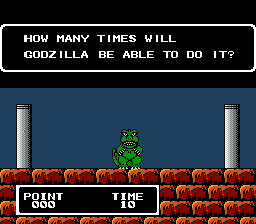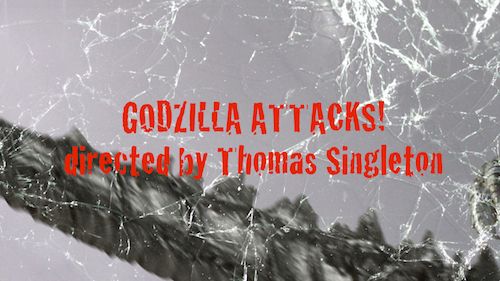Godzilla(Heisei) vs. The real world
Moderator: Controllers
82 posts
• Page 1 of 4 • 1, 2, 3, 4
I think he'd have a better chance of survival if he stayed on land rather than tried fighting the combined naval forces of the world. Of course, he could sink underneath the sea and dissapear...at any rate, there will be a lot of wailing and mashing of teeth.
- CyHunter
- Burning Godzilla
- Posts: 3977
- Joined: Sat Aug 02, 2003 12:17 pm
- Location: Los Angeles, CA

"There are 4 things that I've learned to dont discuss, because they end with people killing each other: Religion, politics, sports, and logic on anime and kaiju movies"
Anibal
-

Mexigojira - Heisei Godzilla
- Posts: 1412
- Joined: Sat Aug 09, 2003 5:49 pm
- Location: Monterrey, Nuevo Léon Mexico
"For God so loved the world, that He gave His one and only Son, that whosoever believes in Him will not perish, but will have eternal life." The Holy Bible - John 3:16
- Kaiju Eiga
- Little Godzilla
- Posts: 118
- Joined: Thu Aug 14, 2003 2:59 pm
- Location: From the vivid imaginations of Kenny and Ichiro...
Re: Godzilla(Heisei) vs. The real world
~Brian~
_______________________________________
1313
_______________________________________
1313
- briizilla
- Burning Godzilla
- Posts: 2224
- Joined: Thu Jan 08, 2004 8:41 am
- Location: Pennsylvania
195' tall sauropod? Yeah, right.
Godzilla's cells are (for whatever reason) able to survive and utilize nuclear energy. Godzilla can thus handle metabolic costs that no normal animal could support, such as growing muscle and bone to titanic strength and resilience. His regeneration is just cell division carried out by millions of super-charged cells.
Godzilla is not a mutant as a result of radiation exposure. His mutation is being able to metabolize radiation. I do not have a link at the moment, but I do recall real-world bacteria which do something similar. In an abstract sense, it's not that much different from redwoods converting less-intense solar radiation into woody trunks that stand as tall as a Godzilla. A difference in degree but not in kind.
Godzilla's ability to survive our modern firepower is pretty much a given, if he's given enough time to regenerate.
I've never seen official range and yield figures for Godzilla's breath weapon, but I'm confident that it at least matches the gunnery range of the tanks I served alongside. The same is true of the majority of anti-tank missiles. Even missiles guided by aircrews have a distinctly finite range. There's a real possibility, varying by the technologies available, that some countries' armies and air forces simply could not inflict lethal damage to Godzilla even assuming they could mass all their mobile forces.
Artillery greatly outranges Godzilla - there would be none of Toho's old depiction of field guns pointing straight at him - but he tends to move around. Conventional shrapnel seems very unlikely to bother Godzilla, and the same goes for the relatively small cluster packages in DPICM. That leaves nuclear, biochem, and guided explosive rounds. Nuking something which either feeds off radiation or melts down is a bad idea. Godzilla might not appreciate nerve gas or nasty bugs, but his radioactive body would definitely reduce the potency of many agents in use today. (Weather conditions alone can seriously degrade some nerve toxins.)
We can reasonably conclude that the best real-world way to hurt Godzilla would be to constantly hit him with large-caliber guided artillery shells and rockets. In doing so we would have to wear him down, forcing him to regenerate enough to decrease his nuclear "fuel." Eventually, the explosives would wound him seriously enough to kill him, and/or he'd finally wander back to the sea and disappear.
Godzilla is much smaller than many warships. However, while modern torpedoes have good range, speed, and yield, naval gunnery is somewhat neglected. Godzilla's ability to use his breath weapon underwater would be a serious problem at close ranges, just as his habit of diving would render most missiles useless. Some missiles do carry depth bomb or torpedo warheads, though, so a well-equipped fleet could harass Godzilla from long range. Still, naval fighting would most likely consist of submarines vs. the monster until he decided otherwise.
I do note that, while torpedoes have quite large explosive payloads compared to artillery shells (except for battleship rounds), they do not have nearly as quick a rate of fire, nor are there all that many total tubes in a given fleet. There is also a small degree of friendly-fire risk when operating too many submarines in a given volume, particularly near a large and deadly monster prone to closing with an enemy.
Godzilla's cells are (for whatever reason) able to survive and utilize nuclear energy. Godzilla can thus handle metabolic costs that no normal animal could support, such as growing muscle and bone to titanic strength and resilience. His regeneration is just cell division carried out by millions of super-charged cells.
Godzilla is not a mutant as a result of radiation exposure. His mutation is being able to metabolize radiation. I do not have a link at the moment, but I do recall real-world bacteria which do something similar. In an abstract sense, it's not that much different from redwoods converting less-intense solar radiation into woody trunks that stand as tall as a Godzilla. A difference in degree but not in kind.
Godzilla's ability to survive our modern firepower is pretty much a given, if he's given enough time to regenerate.
I've never seen official range and yield figures for Godzilla's breath weapon, but I'm confident that it at least matches the gunnery range of the tanks I served alongside. The same is true of the majority of anti-tank missiles. Even missiles guided by aircrews have a distinctly finite range. There's a real possibility, varying by the technologies available, that some countries' armies and air forces simply could not inflict lethal damage to Godzilla even assuming they could mass all their mobile forces.
Artillery greatly outranges Godzilla - there would be none of Toho's old depiction of field guns pointing straight at him - but he tends to move around. Conventional shrapnel seems very unlikely to bother Godzilla, and the same goes for the relatively small cluster packages in DPICM. That leaves nuclear, biochem, and guided explosive rounds. Nuking something which either feeds off radiation or melts down is a bad idea. Godzilla might not appreciate nerve gas or nasty bugs, but his radioactive body would definitely reduce the potency of many agents in use today. (Weather conditions alone can seriously degrade some nerve toxins.)
We can reasonably conclude that the best real-world way to hurt Godzilla would be to constantly hit him with large-caliber guided artillery shells and rockets. In doing so we would have to wear him down, forcing him to regenerate enough to decrease his nuclear "fuel." Eventually, the explosives would wound him seriously enough to kill him, and/or he'd finally wander back to the sea and disappear.
Godzilla is much smaller than many warships. However, while modern torpedoes have good range, speed, and yield, naval gunnery is somewhat neglected. Godzilla's ability to use his breath weapon underwater would be a serious problem at close ranges, just as his habit of diving would render most missiles useless. Some missiles do carry depth bomb or torpedo warheads, though, so a well-equipped fleet could harass Godzilla from long range. Still, naval fighting would most likely consist of submarines vs. the monster until he decided otherwise.
I do note that, while torpedoes have quite large explosive payloads compared to artillery shells (except for battleship rounds), they do not have nearly as quick a rate of fire, nor are there all that many total tubes in a given fleet. There is also a small degree of friendly-fire risk when operating too many submarines in a given volume, particularly near a large and deadly monster prone to closing with an enemy.
Does anyone else listen to Kajagoogoo's "Too Shy" and think of "Save the Earth?"
- Lord Ghidorah
- Godzilla Jr.
- Posts: 481
- Joined: Wed Sep 17, 2003 2:03 am
82 posts
• Page 1 of 4 • 1, 2, 3, 4
Return to Godzilla vs. Gamera: Kaiju Fantasy Fights
Who is online
Users browsing this forum: No registered users and 12 guests






